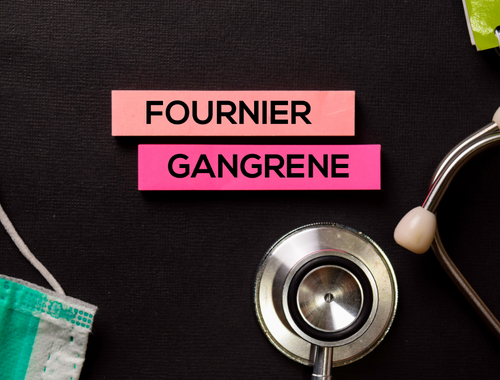Difference Between Fournier’s Gangrene and Necrotizing Fasciitis
Fournier’s gangrene is a debilitating bacterial infection of the genitalia and perineum. It is a type of necrotizing fasciitis as it destroys the tissue and vasculature. Necrotizing fasciitis is an umbrella term for the bacterial infection that causes the necrosis of the fatty subcutaneous skin layer and the fascia. This condition develops from blunt force tissue injury, open wounds, and from cellulitis.

What is Fournier’s gangrene?
Definition:
Fournier’s gangrene is a severe bacterial infection of the genitalia and perineum. It is a type of necrotizing fasciitis as it destroys the tissue and vasculature. This condition is a medical emergency that needs urgent care.
Causes:
Bacteria penetrate the genitalia and rectum secondary to many conditions. These include abscess, diverticulitis, cystitis, urinary tract infection, burn injury, rectal carcinoma, sexual intercourse, and circumcision. The common bacterial species involved in Fournier’s gangrene include E. coli, Klebsiella, Proteus, Streptococcus, Bacteroides, and Clostridium.
Risk factors:
Certain groups of people are at an increased risk of developing Fournier’s gangrene. These include diabetics, alcohol addicts, people with cardiovascular disease, cirrhosis, hypertension, renal failure, elderly patients, obese individuals, smokers, and immunocompromised.
Symptoms:
The prominent symptoms of Fournier’s gangrene include erythema, tenderness, and edema of the genitalia and perineum. Other systemic symptoms are dehydration, fever, lethargy, nausea, vomiting, and sepsis.
Diagnosis:
Blood tests such as complete blood count and lactate are ordered in suspected Fournier gangrene. Imaging tests such as ultrasound, computed tomography (CT) scan, and magnetic resonance imaging (MRI) are essential for confirming the disease and determining its spread.
Treatment:
Surgical debridement is the mainstay treatment for Fournier’s gangrene. Broad-spectrum antibiotics are used postoperatively. Also, hyperbaric oxygen therapy ensures prompt wound healing.

What is necrotizing fasciitis?
Definition:
Necrotizing fasciitis, also referred to as flesh-eating disorder, is an uncommon bacterial infection of subcutaneous tissue and fascia.
Causes:
A broken skin barrier is the main cause of the entry of bacteria which then causes necrotizing fasciitis. Cuts, scrapes, insect bites, and needle punctures are a few of the causes of bacterial entry in necrotizing fasciitis.
Risk factors:
Certain groups are at an increased risk of developing necrotizing fasciitis. These include diabetics, hypertensive individuals, obese patients, adults greater than 50 years old, those with cellulitis, immunocompromised individuals, those with liver or kidney failure, and those taking injectable medications.
Symptoms:
Symptoms of necrotizing fasciitis include pain out of proportion, fever, rapidly spreading erythema, edema, stiffness of the involved body part, paresthesia, blackening and bruising of the skin, blistering, foul-smelling discharge, and septicemia.
Diagnosis:
Necrotizing fasciitis is difficult to diagnose on physical examination. The most important investigation is an X-ray of the affected region which will confirm gas buildup. A CT scan and an MRI scan are further carried out to determine the depth of necrosed tissue and biopsies of the affected area.
Treatment:
Intravenous (IV) broad-spectrum antibiotics and IV fluid resuscitation are super important to control the infection. Dead tissue is removed via debridement surgery. Lastly, if the body part is unsalvageable, radical surgical intervention or amputation needs to be carried out.
Difference between Fournier’s gangrene and necrotizing fasciitis
Definition:
Fournier’s gangrene is a severe bacterial infection of the genitalia and perineum. It is a type of necrotizing fasciitis. Necrotizing fasciitis, also referred to as flesh-eating disorder, is an uncommon bacterial infection of subcutaneous tissue and fascia.
Causes:
Causes of Fournier’s gangrene include abscess, diverticulitis, cystitis, urinary tract infection, burn injury, rectal carcinoma, sexual intercourse, and circumcision. Causes of necrotizing fasciitis include cuts, scrapes, insect bites, and needle punctures.
Risk factors:
Groups of people that are at an increased risk to develop Fournier’s gangrene include diabetics, alcohol addicts, people with cardiovascular disease, cirrhosis, hypertension, renal failure, elderly patients, obese individuals, smokers, and immunocompromised.
Groups that are at an increased risk to develop necrotizing fasciitis include diabetics, hypertensive individuals, obese patients, adults greater than 50 years old, those with cellulitis, immunocompromised individuals, those with liver or kidney failure, and those taking injectable medications.
Symptoms:
The prominent symptoms of Fournier’s gangrene include erythema, tenderness, and edema of the genitalia and perineum. Systemic symptoms are dehydration, fever, lethargy, nausea, vomiting, and sepsis. Symptoms of necrotizing fasciitis include pain out of proportion, fever, rapidly spreading erythema, edema, stiffness of the involved body part, paresthesia, blackening and bruising of the skin, blistering, foul-smelling discharge, and septicemia.
Diagnosis:
Both these conditions are diagnosed via blood tests and radiologic investigations such as ultrasound, CT scans, and MRI scans.
Treatment:
Surgical debridement is the mainstay treatment for both Fournier’s gangrene and necrotizing fasciitis. Broad-spectrum antibiotics and fluid resuscitation are needed to control both infections.
Table of differences between Fournier’s gangrene and necrotizing fasciitis

FAQs
Is Fournier’s gangrene a type of necrotizing fasciitis?
Yes, Fournier’s gangrene is a type of necrotizing fasciitis.
How do you recognize Fournier’s gangrene?
Fournier’s gangrene appears as extensively discolored perineal skin with a foul smell coming from it. The genitalia is tender and edematous. Systemic symptoms such as high-grade fever, malaise, severe pain, and vomiting are common in the condition.
What is the distinguishing clinical feature of necrotizing fasciitis?
The affected skin is warm, tender, edematous, and foul-smelling.
What are the two types of necrotizing fasciitis?
Type I (polymicrobial) and type II (monomicrobial) are the two types of necrotizing fasciitis.
What is the difference between gangrene and necrotizing fasciitis?
Gangrene is the death of tissues due to a deficient blood supply. Necrotizing fasciitis is a bacterial infection that causes the necrosis of the fatty subcutaneous skin layer and the vasculature-containing fascia.
Are gangrene and necrosis the same thing?
Gangrene is the death of tissues due to deficient blood supply whereas necrosis is the phenomenon of irreversible cell death.
- Differences Between Reptiles and Amphibians - May 17, 2024
- Difference Between Ophthalmology and Optometry - May 15, 2024
- Difference Between Fear and Anxiety - April 2, 2024
Search DifferenceBetween.net :
Leave a Response
References :
[0]Morpurgo, Emilio, and Susan Galandiuk. "Fournier's gangrene." Surgical Clinics 82.6 (2002): 1213-1224.
[1]Green, Ronald J., Donald C. Dafoe, and Thomas A. Rajfin. "Necrotizing fasciitis." Chest 110.1 (1996): 219-229.
[2]Shyam, Devajit Chowlek, and Amy Grace Rapsang. "Fournier's gangrene." The Surgeon 11.4 (2013): 222-232.
